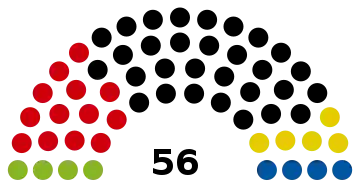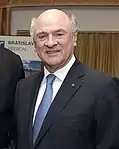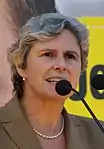2013 Lower Austrian state election
The 2013 Lower Austrian state election was held on 3 March 2013 to elect the members of the Landtag of Lower Austria.
| |||||||||||||||||||||||||||||||||||||||||||||||||||||||||||||||||||||||
All 56 seats in the Landtag of Lower Austria 29 seats needed for a majority All 9 seats in the state government | |||||||||||||||||||||||||||||||||||||||||||||||||||||||||||||||||||||||
|---|---|---|---|---|---|---|---|---|---|---|---|---|---|---|---|---|---|---|---|---|---|---|---|---|---|---|---|---|---|---|---|---|---|---|---|---|---|---|---|---|---|---|---|---|---|---|---|---|---|---|---|---|---|---|---|---|---|---|---|---|---|---|---|---|---|---|---|---|---|---|---|
| Turnout | 975,746 (70.9%) | ||||||||||||||||||||||||||||||||||||||||||||||||||||||||||||||||||||||
| |||||||||||||||||||||||||||||||||||||||||||||||||||||||||||||||||||||||
 Results by municipality. | |||||||||||||||||||||||||||||||||||||||||||||||||||||||||||||||||||||||
| |||||||||||||||||||||||||||||||||||||||||||||||||||||||||||||||||||||||
The Austrian People's Party (ÖVP) retained its majority. The main winner of the election was the new Team Stronach, which debuted at 9.8%. It drew votes from the ÖVP, Social Democratic Party of Austria (SPÖ) and Freedom Party of Austria (FPÖ).[1]
Background
The Lower Austrian constitution mandates that cabinet positions in the state government (state councillors, German: Landesräten) be allocated between parties proportionally in accordance with the share of votes won by each; this is known as Proporz. As such, the government is a perpetual coalition of all parties that qualify for at least one state councillor. After the 2008 election, the ÖVP had six councillors, the SPÖ two, and the FPÖ one.
Electoral system
The 56 seats of the Landtag of Lower Austria are elected via open list proportional representation in a two-step process. The seats are distributed between twenty multi-member constituencies. For parties to receive any representation in the Landtag, they must either win at least one seat in a constituency directly, or clear a 4 percent state-wide electoral threshold. Seats are distributed in constituencies according to the Hare quota, with any remaining seats allocated using the D'Hondt method at the state level, to ensure overall proportionality between a party's vote share and its share of seats.[2]
Contesting parties
The table below lists parties represented in the previous Landtag.
| Name | Ideology | Leader | 2008 result | ||||
|---|---|---|---|---|---|---|---|
| Votes (%) | Seats | Councillors | |||||
| ÖVP | Austrian People's Party Österreichische Volkspartei |
Christian democracy | Erwin Pröll | 54.4% | 31 / 56 |
6 / 9 | |
| SPÖ | Social Democratic Party of Austria Sozialdemokratische Partei Österreichs |
Social democracy | Josef Leitner | 25.5% | 15 / 56 |
2 / 9 | |
| FPÖ | Freedom Party of Austria Freiheitliche Partei Österreichs |
Right-wing populism Euroscepticism |
Barbara Rosenkranz | 10.5% | 6 / 56 |
1 / 9 | |
| GRÜNE | The Greens – The Green Alternative Die Grünen – Die Grüne Alternative |
Green politics | Madeleine Petrovic | 6.9% | 4 / 56 | ||
In addition to the parties already represented in the Landtag, five parties collected enough signatures to be placed on the ballot.[3]
- Team Stronach (FRANK)
- Communist Party of Austria (KPÖ) – on the ballot only in 19 constituencies
- The Brave Citizens (MUT) – on the ballot only in 13 constituencies
- Christian Party of Austria – Centre Party (CPÖMP) – on the ballot only in 4 constituencies
- Pirate Party of Austria (PIRAT) – on the ballot only in 1 constituency
Results
 | ||||||||
| Party | Votes | % | +/− | Seats | +/− | Coun. | +/− | |
|---|---|---|---|---|---|---|---|---|
| Austrian People's Party (ÖVP) | 495,557 | 50.79 | –3.60 | 30 | –1 | 6 | ±0 | |
| Social Democratic Party of Austria (SPÖ) | 210,504 | 21.57 | –3.94 | 13 | –2 | 2 | ±0 | |
| Team Stronach (FRANK) | 90,016 | 9.84 | New | 5 | New | 1 | New | |
| Freedom Party of Austria (FPÖ) | 80,122 | 8.21 | –2.26 | 4 | –2 | 0 | –1 | |
| The Greens – The Green Alternative (GRÜNE) | 78,678 | 8.06 | +1.15 | 4 | ±0 | 0 | ±0 | |
| Communist Party of Austria (KPÖ) | 7,559 | 0.77 | –0.09 | 0 | ±0 | 0 | ±0 | |
| The Brave Citizens (MUT) | 5,968 | 0.61 | New | 0 | New | 0 | New | |
| Christian Party of Austria – Centre Party (CPÖMP) | 841 | 0.09 | –0.75 | 0 | ±0 | 0 | ±0 | |
| Pirate Party of Austria (PIRAT) | 501 | 0.05 | +0.05 | 0 | ±0 | 0 | ±0 | |
| Invalid/blank votes | 19,527 | – | – | – | – | – | – | |
| Total | 995,273 | 100 | – | 56 | 0 | 9 | 0 | |
| Registered voters/turnout | 1,404,454 | 70.87 | –3.64 | – | – | – | – | |
| Source: Lower Austrian Government | ||||||||
Results by constituency
| Constituency | ÖVP | SPÖ | FRANK | FPÖ | Grüne | Others | Total seats |
Turnout | |||||
|---|---|---|---|---|---|---|---|---|---|---|---|---|---|
| % | S | % | S | % | S | % | S | % | S | % | |||
| Amstetten | 53.5 | 2 | 20.2 | 1 | 9.0 | 7.9 | 7.6 | 1.8 | 3 | 74.6 | |||
| Baden | 42.9 | 1 | 22.6 | 1 | 14.4 | 8.9 | 9.4 | 1.9 | 2 | 67.0 | |||
| Bruck an der Leitha | 50.2 | 23.7 | 10.9 | 8.1 | 5.7 | 1.4 | 0 | 69.1 | |||||
| Gänserndorf | 46.8 | 1 | 25.8 | 10.7 | 8.9 | 6.2 | 1.6 | 1 | 67.3 | ||||
| Gmünd | 50.5 | 28.1 | 9.0 | 6.7 | 4.9 | 0.9 | 0 | 75.3 | |||||
| Hollabrunn | 58.1 | 1 | 20.3 | 7.9 | 7.0 | 5.3 | 1.4 | 1 | 74.5 | ||||
| Horn | 64.1 | 15.6 | 6.7 | 7.4 | 5.8 | 0.5 | 0 | 76.3 | |||||
| Korneuburg | 51.1 | 1 | 18.1 | 10.1 | 8.0 | 11.0 | 1.8 | 1 | 69.8 | ||||
| Krems an der Donau | 56.1 | 1 | 19.1 | 7.8 | 7.6 | 7.4 | 1.9 | 1 | 74.5 | ||||
| Lilienfeld | 49.1 | 27.4 | 8.9 | 7.7 | 5.9 | 1.0 | 0 | 76.3 | |||||
| Melk | 51.8 | 1 | 22.6 | 8.1 | 9.3 | 6.3 | 1.8 | 1 | 76.6 | ||||
| Mistelbach | 57.3 | 2 | 19.1 | 8.4 | 7.8 | 6.8 | 0.7 | 2 | 74.0 | ||||
| Mödling | 45.3 | 2 | 18.6 | 11.9 | 7.2 | 14.8 | 2.2 | 2 | 65.7 | ||||
| Neunkirchen | 48.0 | 1 | 26.0 | 9.6 | 8.6 | 6.3 | 1.6 | 1 | 70.5 | ||||
| Sankt Pölten | 47.4 | 2 | 24.3 | 1 | 9.5 | 8.6 | 8.4 | 1.9 | 3 | 71.7 | |||
| Scheibbs | 55.8 | 1 | 21.6 | 7.4 | 7.3 | 5.5 | 2.4 | 1 | 77.0 | ||||
| Tulln | 53.8 | 1 | 18.4 | 9.6 | 8.1 | 9.3 | 0.8 | 1 | 71.7 | ||||
| Waidhofen an der Thaya | 56.8 | 18.6 | 8.1 | 10.6 | 5.9 | 0 | 74.7 | ||||||
| Vienna Surrounds | 43.4 | 1 | 21.9 | 11.9 | 8.5 | 13.0 | 1.3 | 1 | 62.1 | ||||
| Zwettl | 64.7 | 1 | 13.7 | 7.3 | 8.5 | 5.4 | 0.5 | 1 | 78.3 | ||||
| Remaining seats | 11 | 10 | 5 | 4 | 4 | 34 | |||||||
| Total | 50.8 | 30 | 21.6 | 13 | 9.8 | 5 | 8.2 | 4 | 8.1 | 4 | 1.5 | 56 | 70.9 |
| Source: Lower Austrian Government | |||||||||||||
Preference votes
Alongside votes for a party, voters were able to cast a preferential votes for a candidate on the party list. The ten candidates with the most preferential votes were as follows:[4]
| Party | Pos. | Candidate | Votes | % | |
|---|---|---|---|---|---|
| ÖVP | 1 | Erwin Pröll | 267,482 | 88.4 | |
| SPÖ | 1 | Josef Leitner | 39,706 | 61.0 | |
| FRANK | 1 | Frank Stronach | 29,728 | 83.5 | |
| FPÖ | 1 | Barbara Rosenkranz | 29,099 | 81.2 | |
| GRÜNE | 1 | Madeleine Petrovic | 19,690 | 67.8 | |
| ÖVP | 4 | Stefan Pernkopf | 5,635 | 1.9 | |
| ÖVP | 6 | Karl Wilfing | 4,579 | 1.5 | |
| ÖVP | 25 | Bettina Rausch | 3,118 | 1.0 | |
| SPÖ | 4 | Heidamaria Onodi | 2,747 | 4.2 | |
| FRANK | 2 | Ernest Gabmann Jr. | 2,778 | 7.8 | |
Aftermath
The ÖVP retained its Landtag majority and six out of nine state councillors; the SPÖ also retained its two councillors. The FPÖ lost their sole state councillor to Team Stronach.
References
- "State of Lower Austria – Landtag election 2013". Lower Austrian Government.
- "ROS - NÖ Landtag electoral law 1992 - State law for Lower Austria, version of 04.08.2020". Lower Austrian Government.
- "Parties". Lower Austrian Government.
- "Candidates". Lower Austrian Government.




